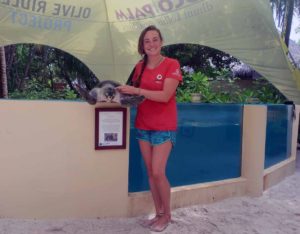
What is life like as a Sea Turtle Vet on a remote island in the Indian Ocean? Dr Claire Lomas BVM&S MRCVS is ORP’s Sea Turtle Veterinarian in residence at the Marine Turtle Rescue Centre in Baa Atoll. She reveals the highlights and challenges of life as a Sea Turtle Vet.
A Dream Come True
It has always been my dream to work in conservation as a veterinarian and I have always had a fascination with the ocean and marine life. I have a passion to help preserve the 70% part of our planet that is ocean, from the impacts of our land-based species. So I was elated to start working for Olive Ridley Project as a Sea Turtle Vet in August 2017.
The Olive Ridley Project Marine Turtle Rescue Centre is the first, and currently only, of its kind in Maldives. This exciting pioneering clinic means turtles in Maldives can now receive veterinary care for the first time. However, it also presents challenges operating in a country without the framework of a veterinary profession. There are also challenges and joy associated with working and living on a small remote island in the Indian Ocean.
No Two Days Are The Same
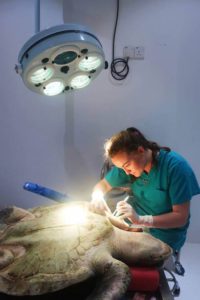
Days at the Marine Turtle Rescue Centre are always varied; we never know when a new turtle call may come in so we have to be prepared around the clock. Our island Rescue Centre team is small with just an intern, one or two volunteers, and myself at a time, which means that the job is not just limited to veterinary work. I also must ensure that the turtles are fed and that the tanks are clean and running smoothly. I have even learnt bits about engineering and plumbing since working with our tank system!
Another part of the job is community outreach. I organise school trips and other events to help raise awareness of sea turtle conservation in the Maldives. We also monitor the nesting on the island and are fortunate enough to watch the hatching of baby turtles.
Ghost Gear Victims
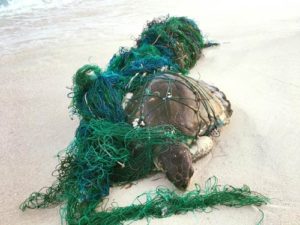
Of course, the most interesting part of the job is when I can put my veterinary skills to use and help out the turtles who come to our Rescue Centre. The most common cases we see here in Maldives are olive ridley turtles that have been found entangled in ghost gear (discarded or lost fishing nets in the ocean). It can be difficult to see turtles arrive with devastating and painful injuries. Many times I have had to think hard about where to start in surgery due to the extent of the wounds.
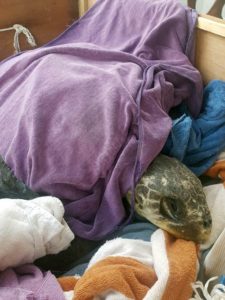
When a call comes in, I have to try to get the turtle to us by organising transport by seaplanes or boats. We also work with other rescue centres in the Maldives to help turtles receive the care they need. The turtles are found all over the country and many take two seaplanes rides to reach us. They often arrive dehydrated and weak, so we start emergency first aid treatments involving administering fluids and stopping any bleeding.
Most will have surgery the day they arrive either to repair wounds or amputate flippers that are too badly damaged from the nets. For those that are weaker, or have injuries that don’t immediately require surgery, it is best to wait a few days to ensure the turtle is hydrated and stronger before giving them an anaesthetic.
Critically Endangered Hawksbills
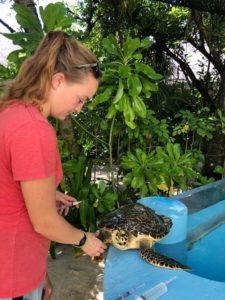
Other cases we see involve hawksbill turtles. Hawksbills are critically endangered, so each case feels very precious. Most of the ones we have seen have swallowed fishing hooks and therefore require surgery. We have also had a few that have been found sick and floating from natural causes. These are always a challenge due to the limitations of equipment we have on a remote island. Without access to diagnostic equipment found in most UK veterinary practices, it can be difficult to find out the exact cause of illness.
We have also had the occasional green turtle in our Rescue Centre. Most have been young turtles – some having been kept as pets and needing rehabilitating. The older green turtles we see are often victims of illegal hunting that unfortunately still happens in some parts of the country.
Buoyancy Syndrome
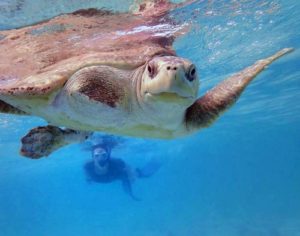
The most challenging and frustrating cases are the buoyant olive ridleys. Buoyancy syndrome affects the majority of the olive ridley turtles coming to our centre. It has many causes but comes down to gas trapped in parts of the body. We have many cases that become chronically buoyant, that is, the buoyancy does not resolve after a couple of months.
Many of the chronically buoyant turtles have tears in their lungs from the trauma of ghost net entanglement. This means the air from the lungs leaks into the shell and cannot escape, causing the turtle to float. Without expensive and technical surgical equipment to fix these lungs tears, treatment is palliative.
Thankfully, there are some causes of buoyancy syndrome that we can treat and some do recover from chronic buoyancy syndrome. It is always a great joy to see these turtles take their first dives and then one day find them at the bottom of the tank.
Limited Facilities
There are many challenges working as a sea turtle vet here, including limited access to specialist drugs, equipment and the unique aspects of working on a small remote island. As a charity reliant on donations, we are forever fundraising and slowly building up our clinic with equipment and facilities. I am very excited for the day I can X-ray a turtle without taking a boat to a human hospital! In future having equipment like an ultrasound machine and endoscopes will allow us to expand our veterinary capabilities and the care we can offer to our patients.
Unique Patients

A final challenge is our patients – the turtles! Sea turtle medicine and surgery, as you can imagine, is a very niche area of veterinary medicine. There is very little literature and research that has been carried out on veterinary topics like diseases, treatments and drug doses, particularly for olive ridley turtles. Vets are trained to treat based off scientific evidence, which is often impossible here! As a Sea Turtle Vet, you have to pull knowledge and skills from all aspects of veterinary medicine, other species, as well as learning from the research that has been done in sea turtles.
Releases
There are many highlights to the job as a sea turtle vet, particularly the releases. We get very attached to our turtle patients. We take care of them from their arrival with terrible injuries and nurture them through to the point they can return to the ocean. Seeing a healthy and strong turtle swim away is one of the best feelings. It has definitely brought a tear to my eye on occasion!
Miraculous Recoveries
It is a great highlight when turtles prove just how stoic and strong they really are. As a species they have a remarkable ability to heal from severe injuries. Two cases come to mind which astounded me of the capability of these extraordinary creatures:
Chanel
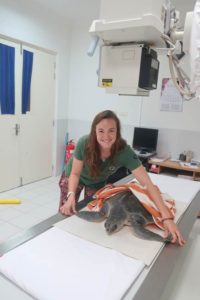
Chanel arrived on the island the day before I did. She was quiet and lethargic with severe deep wounds to her front flippers from ghost net entanglement. She had two exposed broken bones on either side, and the net had nearly cut through the muscles in her front flippers. We were worried she may lose these flippers and she was not using them at first.
We performed surgery to try and repair the damage. New research is showing the remarkable ability of sea turtles to re-grow nerves and blood vessels into damaged areas. Although many of our turtle patients need amputations, we try, wherever possible, to save their flippers. Chanel turned into a feisty and strong turtle with full use of her front flippers. To this day, she has been my favourite and most heart-felt releases.
Chouchou
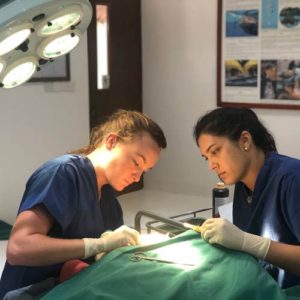
The other case that will stick with me is that of Chouchou. Chouchou required surgery to remove part of a bone left after a ghost net amputated most of her front flipper. To give this young turtle the best possible chance, we delayed her surgery a short time, until she was stronger and fully hydrated.
Despite all our precautions, anaesthetics carry a risk. The surgery went well and Chou started recovering as normal from the anaesthetic. Around 6 hours later she quickly declined, stopped breathing and lost most of her normal reflexes. We test certain reflexes under anaesthetic to see how awake a turtle is. Chou lost all of these reflexes, including her corneal reflex. This is a sign used to confirm death in many species.
Sea turtles, and other reptiles, still have a heart beat after death, so finding a heart beat is not a reliable sign of life in these species. With great dismay and stubbornness, we refused to give up on Chou and continued to resuscitate her for 36 hours. This involved breathing for her with a bag and administering adrenaline to keep her heart beating strong. We kept trying to stimulate her to regain consciousness.
After an exhausting two days of no sleep, this turtle made a miraculous recovery to full health. She went on to be released one month later. This has taught me to never give up and further affirms my admiration for this wonderful species.
Volunteer At The Rescue Centre
Working as a sea turtle vet is an incredible experience. It both challenges me daily and brings me great happiness to help these wonderful wild animals. I can highly recommend coming to volunteer at the Rescue Centre to see first-hand what we do and learn more about sea turtle veterinary work.

